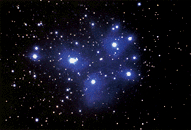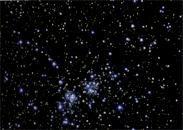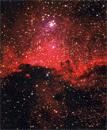The constellations.
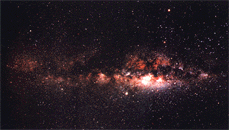 How many stars are there in the sky? Firstly it seems
difficult to give the exact answer on this quastion, but it is not so. It is very easy to
count all the stars. In the light moonless night a man with a good eyesight can see 3000
stars. Approximatly the same number is under the horison.
How many stars are there in the sky? Firstly it seems
difficult to give the exact answer on this quastion, but it is not so. It is very easy to
count all the stars. In the light moonless night a man with a good eyesight can see 3000
stars. Approximatly the same number is under the horison.
Our forcomers entired groups of stars in to constellations for the easy
orientation. The constellations are the groups of stars being in the same direction from
us. But the distance to them may be different.
The careful star count showed that they are dislocated very
uneven. Many of them are gathered in compact groups - congestions.
The observations in XIX c allowed to understand that
"the star heaps" of Gershel are divided into two classes by their appearence.
One of them, the ball-shaped, were called due to their form. In the external layers of
these congestions there were the weak stars seen by the telescope. However in the centre
of the congestion the stars lacated so compact, that seemed to be a single shining mass.
it is curiously that all the ball-shaped congestions were seen in one side of the sky in
semisphere with the centre in the Marksman constellation.
The ballball-shaped congestion |
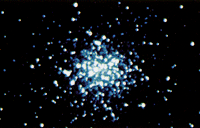
|
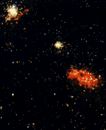
|
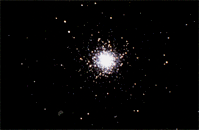
|
The congestions of the second class are the
rarefied congestions, were only in the Milky Way limits or near it. If comparing with
the ball-shaped they had a less star compactness and the indefinite form.
Nowadays the star congestions are the groups of stars
connected by the general origin, state in the space and motion. These congestions differ
from the constellations, which are the result of ocasional dislocation coincidence of the
stars in the sky. The division of congestions on the ball-shaped or spherical and rarefied
ones is true now and in the second half of our century one more type of the stars
accumulation was added - associations, which as a rule connected with the massive
clouds of the cold gas, where the stars are orogonated from. The star congestions are the
defenite type star groups having the same origin. There are OB - assocoations with a lot
of hot stars of spectrum classes O and B and T - associations with the variable stars (T
Calf type). It is considered that the star associations belong to the yougest formations
in the Galaxy.
The more careful investigations showed that the difference
between the ball-shaped and rarefied congestions is not only in appearence, the number of
stars and their compactness. They also differ in the chemical composition, the position in
the Galaxy, age, the stars type in the congestions.
 How many stars are there in the sky? Firstly it seems
difficult to give the exact answer on this quastion, but it is not so. It is very easy to
count all the stars. In the light moonless night a man with a good eyesight can see 3000
stars. Approximatly the same number is under the horison.
How many stars are there in the sky? Firstly it seems
difficult to give the exact answer on this quastion, but it is not so. It is very easy to
count all the stars. In the light moonless night a man with a good eyesight can see 3000
stars. Approximatly the same number is under the horison.


